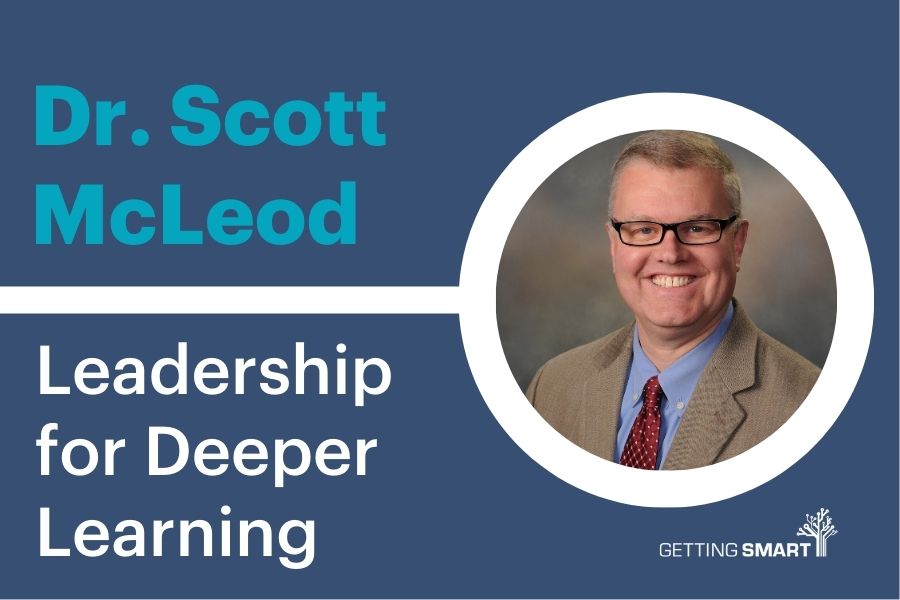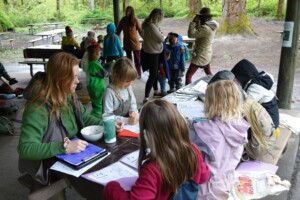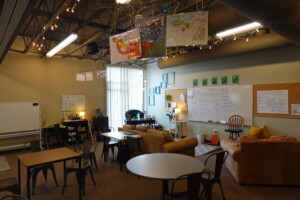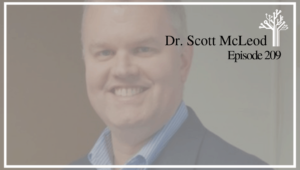Dr. Scott McLeod on Leadership for Deeper Learning
Key Points
-
Vision is important, but it can’t succeed without capacity building.

On this episode of the Getting Smart Podcast, Tom Vander Ark is joined by Dr. Scott McLeod, a Professor of Leadership for Educational Organizations at the University of Colorado Denver and author of numerous books, most recently Leadership for Deeper Learning. Scott is also a Senior Fellow at Getting Smart.
Tom Vander Ark Scott, what is deeper learning?
Scott McLeod The schools I work with tend to define deeper learning in four big buckets or shifts. Bucket number one is the shift in cognitive complexity. How do we get beyond the traditional factual recall and procedural regurgitation that schools are known for? How do we move up Bloom’s taxonomy or around Webb’s Depth of Knowledge wheel to engage in rich, robust critical thinking, problem-solving, creativity, collaboration, and communication—all that higher-level thinking that kids need today? That’s bucket number one. Bucket or shift number two is really about student agency. How can we make learning less teacher- or system-directed and allow kids to drive and direct their own learning more often? When students have more control, voice, and choice, their engagement and motivation go way up. This shift also allows for better personalization and differentiation. So that’s bucket number two. Bucket number three introduces a real-world, authentic lens, addressing the common student question: “Why do I need to know this?” By embedding place-based, community-connected learning with real-world tasks, audiences, and outside partners, we help kids find meaning and relevance in their studies. The fourth big shift is from analog to digital. Most of us went kicking and screaming in that direction during the pandemic, but now, more than ever, we want our kids to be technology-literate and information-fluent. Technology shouldn’t just be used for technology’s sake; it can be a powerful lever for the first three shifts. It allows us to do different kinds of thinking work, create more authentic learning experiences, and give students greater agency than they’d have without it. So, deeper learning is a combination of these four shifts—creating rich, robust learning experiences where students engage with the world around them, use technology meaningfully, drive their own learning, and focus on much deeper thinking and problem-solving than you typically see in traditional school settings.
Tom Vander Ark That’s a beautiful definition. You’ve clearly been thinking about this for a while. This is the Getting Smart Podcast, and I’m Tom Vander Ark. Today, I have the pleasure of being joined by Dr. Scott McLeod. Scott is a professor of leadership at the University of Colorado Denver, my old hometown. He has authored several books on deeper learning, with the latest being Leadership for Deeper Learning. This spring, during a sabbatical from his teaching responsibilities, Scott is serving as a senior fellow at Getting Smart. Scott, it’s great to have you on the podcast. I think of you as the leading authority on leading for deeper learning.
Scott McLeod Thanks, Tom. It’s nice to be back.
Tom Vander Ark Why deeper learning? Why do you think it matters? You touched on this in your definition, but why is it important to promote and encourage deeper learning?
Scott McLeod I think there are a couple of big reasons. First, it’s about student meaning-making and engagement. We’ve always known that the traditional, one-size-fits-all model doesn’t work for everyone. This approach leaves many students feeling disenchanted and disengaged. Some physically drop out, while others mentally check out, even if they appear to play the game of school. They’re just going through the motions, year by year, class by class. We can do so much better. Deeper learning activates students’ interests, passions, and relevance in a more robust way than traditional content coverage. From a societal perspective, there’s an increased demand for a different skill set—one that goes beyond routine mental work and involves hands-on, applied learning that has meaningful impacts in communities and the world. This is something you don’t often find in traditional schools, where the focus is mainly on textbooks, worksheets, and lectures. So, there are compelling reasons for deeper learning—from both student and societal perspectives.
Tom Vander Ark Yes, and you mentioned student agency. You can’t develop genuine student agency without deeper learning. Agency is essential for fostering initiative and an entrepreneurial mindset, which feels like another critical reason for deeper learning, along with the cognitive skills you mentioned.
Scott McLeod Absolutely. I read somewhere that people need individuals who can self-direct and manage their own work—no one wants to hire someone who only complies and regurgitates information.
Tom Vander Ark You’ve been studying this topic for about 15 years. Where do you find deeper learning? When you do find it, what are the typical conditions?
Scott McLeod I think it starts with dissatisfaction with the traditional model. People are eager for something different, and the question becomes how and where we can create new learning experiences for kids. Some of this work has traditionally existed outside of schools in extracurricular programs, clubs, and community centers. When we see deeper learning within schools, it often emerges in startups like charter or independent schools, where there’s a stronger focus on shifting away from traditional models. In larger districts, even when they recognize the need for deeper learning, it’s often siloed within a handful of schools, as if these schools are a buffer to prevent systemic change. It’s great that some schools are exploring deeper learning, but what about the others?
Tom Vander Ark So, Scott, I’d love to have you describe some examples of deeper learning. Maybe start at the elementary level and move up through middle school and high school. Could you share a story or example of something you’ve seen that illustrates what deeper learning looks like at each level?
Scott McLeod Sure, I’ll share an example from our neighbors up the road in the St. Vrain School District, which I think you visited recently. St. Vrain runs a wonderful summer Innovation Academy where they partner with IBM. The program is structured over two weeks: in the first week, kindergarten through second graders visit IBM to learn about IBM’s smart initiatives—things like smart cities, smart energy, and smart transportation. In the second week, these students come to the district, and grades three through five visit IBM. During this second week, the students engage in the design-thinking process, where they build and prototype solutions based on what they learned at IBM. It’s a hands-on, collaborative experience with a focus on presenting and defending their work. It’s a vibrant environment filled with energy and excitement, with elementary kids eager to share their inventions and ideas. They’re learning critical thinking, problem-solving, effective communication, and gaining real-world insights into societal problems and solutions. It’s truly amazing to see.
Tom Vander Ark That’s incredible. And then, just up the street, there’s Altona Middle School, which is like a deeper learning playground with an Idea Lab, a maker space, and a robotics lab. I was there last week, and it was mind-blowing to watch the students not only working but leading projects.
Scott McLeod Yes, absolutely. There’s this perception that deeper learning is mostly for secondary students, but there are lots of powerful examples of elementary and middle school students doing really cool, impactful work.
Tom Vander Ark How about high school? Can you share a picture of what deeper learning might look like at that level?
Scott McLeod Certainly. I’m drawn to the work done at New Village Girls Academy in Los Angeles. This school serves a challenging demographic, with students who have faced numerous societal obstacles. They engage students in real-world inquiry projects with external partners and send them out into the community as interns two days a week. The goal isn’t just free labor; it’s about teaching them how to manage and run workplaces. They’re also learning how to stay centered amidst chaos and make positive contributions to their community. It’s a beautiful example of place-based, community-driven learning. Another example that comes to mind is Butler Tech in Hamilton, Ohio. They started as an adult learning space but have since expanded into high school and middle school programs. Students gain real-world certifications, work with community partners, and have a “fifth day” program where they’re out in the community gaining skills, catching up on academics, or working in jobs. They even bought an amusement park to use as a learning space! It’s truly ahead of its time in career and technical education.
Tom Vander Ark That’s amazing. I also think of the CAPS Network, which includes 200 school districts across the country focused on profession-based learning. It’s all about place-based learning linked to businesses, where students often work on client-connected projects. The last time I visited the CAPS Center in Blue Valley, Kansas, students were building an airplane, launching businesses, and conducting bio-ag research on site. It’s another incredible deeper learning environment.
Scott McLeod Absolutely. At these schools, students work with outside partners in almost every field imaginable. It’s night and day from the options we had when I was in high school, where you could choose from a few hands-on programs like construction, cosmetology, and auto mechanics. Today, students have so many more choices, and with inquiry projects, passion projects, genius hour, CTE programs, internships, and capstones, there’s something interesting happening everywhere.
Tom Vander Ark Scott, just before we started recording, we were talking about our friend Trace Pickering from Iowa BIG, another half-day program for juniors and seniors where students engage in community-connected projects. You feature that program in your book, right?
Scott McLeod Yes, Iowa BIG is a great example. The premise is that students work on projects in collaboration with community partners. They’re at the point now where outside organizations are coming to them, asking students to take on their projects. City and county agencies, local companies, startups, and nonprofits regularly approach the school, and students are working on amazing projects. They’ve built aquatic drones to clean up plastic waste, made documentaries for the county government, and even created a young women’s entrepreneurship community and an annual conference. It’s hard to predict what students will be working on when you visit—they could be developing machine vision technology or designing arthritis-friendly utensils for senior citizens. There’s always something impactful happening.
Tom Vander Ark You’ve mentioned place-based learning a few times, which makes me want to plug our book, The Power of Place. We wrote it right at the beginning of the pandemic, and it features around 50 schools doing place-connected work. That’s an essential part of deeper learning—many schools doing this work are deeply connected to their local communities.
Scott McLeod Yes, absolutely. Trace Pickering at Iowa BIG often tells me about students who initially couldn’t wait to leave Cedar Rapids, Iowa, but changed their minds after participating in Iowa BIG. They saw how they could make an impact in their community and formed a connection with Cedar Rapids. Now, they’re excited to go to college and come back to make a difference in the place they’re from.
Tom Vander Ark That’s a beautiful aspect of deeper learning. It’s about helping students fall in love with where they’re from and seeing their community as a part of their identity. It empowers them to make their community a better place. We’ve talked about various examples of deeper learning. What have you learned about deeper learning leadership? Can you describe the characteristics typical of leaders who create environments like these?
Scott McLeod Definitely. One of the primary traits we see in these leaders is incredible courage and bravery. They’re pushing for these models of learning in the face of deeply embedded traditional mindsets. If you take someone who thinks about school in a very traditional way and put them into a deeper learning environment, it can feel disorienting. It’s different from what they’re used to, with less focus on textbooks, teacher lectures, and state tests. Some deeper learning leaders have even been pushed out of certain communities, but they’ve eventually found places where they can make a difference. Another strong trait is a commitment to equity. Many of these leaders are focused on helping traditionally marginalized students, families, and communities find success outside the “game of school.” They offer something different for students who might otherwise struggle. There’s a strong emphasis on creating a more robust, meaningful learning experience rather than just regurgitating information. They’re also able to translate their vision into day-to-day practice. They have a solid intentionality in their processes and leadership behaviors, ensuring their vision is supported by the necessary structures while still allowing flexibility and agency for students and teachers. These leaders trust their teachers in ways that many traditional schools don’t. Teachers and students are co-designers of the learning experience, which fosters innovation, autonomy, and a culture of trust.
Tom Vander Ark How do leaders communicate their vision and bring people along with them?
Scott McLeod They do two main things. First, they offer a more compelling vision of student learning than just test scores. While many schools and districts are focused on traditional assessments, these leaders emphasize that they want graduates who can do more than just take tests. They set high expectations and provide support structures, but within that framework, teachers and students have the freedom to make learning their own. Secondly, they focus on building capacity. Often, schools with a charismatic leader see progress, but when that leader leaves, the momentum stops. These deeper learning environments aren’t dependent on one person. They create a collective belief system and capacity, so that if the principal or leader leaves, the vision and practices continue.
Tom Vander Ark We’re talking to Dr. Scott McLeod about his new book, Leadership for Deeper Learning. Scott, what’s the equity issue around deeper learning?
Scott McLeod Unfortunately, many students, particularly those in traditionally marginalized groups—students of color, those from low-income families, English language learners, and students with disabilities—often struggle to find meaning in traditional learning tasks. These schools are exceptional at re-engaging students who may have checked out, whether physically or mentally. They offer meaningful, authentic experiences where students can operate as collaborators and make a difference. This type of learning engages students who might otherwise feel disconnected by providing hands-on, impactful projects with real-world applications. That’s a huge equity piece—ensuring all students have access to these future-ready, life-ready opportunities.
Tom Vander Ark It pains me that the pandemic was so hard on students, especially underserved students. Our response, in many cases, has been to double down on mind-numbing work that’s the opposite of deeper learning. Is that really the answer?
Scott McLeod No, I’ve seen that too. The emphasis on “learning loss” has led many to focus solely on test scores and low-level content. Yes, kids need to know and be able to do things, but doubling down on things they dislike isn’t going to help them catch up. During the pandemic, deeper learning schools adapted more readily because their students were used to autonomy and agency. In traditional settings, students struggled without constant teacher direction, but in competency-based and deeper learning environments, students were able to self-direct, adapting much better.
Tom Vander Ark So, what’s new and what’s next for deeper learning? Have you developed new ways to get the word out about deeper learning?
Scott McLeod I’m trying! Thanks for making me a Senior Fellow for Getting Smart this spring. I’m on sabbatical, and since much of the conversation around deeper learning has focused on secondary education, I’m working to unpack what it looks like in grades K through 8. My wife, dog, and I are road-tripping around the country to visit innovative elementary and middle schools. So, if anyone listening knows of a really cool K-8 school we should visit, let me know! We’re also creating resources to reach people anywhere. One is a new podcast called Leader Talk, which is essentially the Leadership for Deeper Learning book in podcast form. We invite principals from deeper learning schools to share their leadership behaviors and support structures that make this type of teaching and learning possible. That podcast is available at leader talk.org. The second podcast we started is Redesigning for Deeper Learning, where my colleagues Julie, Lai, and I help teachers bring their lessons and units to us for on-air redesigns focused on deeper, more robust learning. It’s like real-time instructional coaching, and we hope these will provide practical examples for educators.
Tom Vander Ark Check out Leadership for Deeper Learning, Scott McLeod’s new book. Every school leader should read it, and I can’t wait to listen to those podcasts. They’ll be fun with the real-time design work—maybe I’ll call in with a problem and see if Dr. McLeod can fix it! Scott, we really appreciate your work. We’ve loved all your books, and this new one is a fantastic contribution. Thanks for joining us today.
Scott McLeod Thanks for the opportunity, Tom. It’s always great to talk with you.
Tom Vander Ark And thanks to our producer, Mason Pasha, and the whole Getting Smart team for making this possible. Until next week, keep learning, keep leading, and keep innovating for equity.
Links:








0 Comments
Leave a Comment
Your email address will not be published. All fields are required.